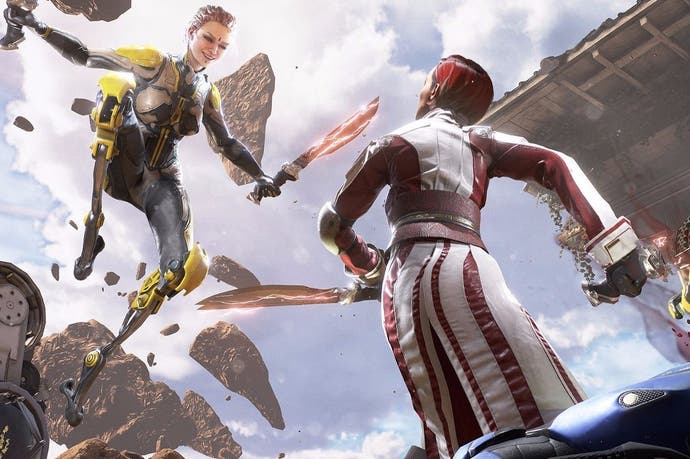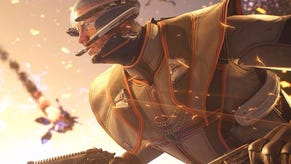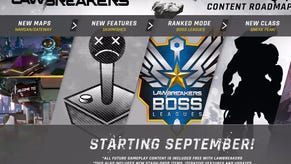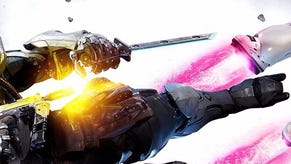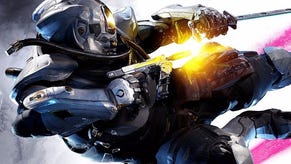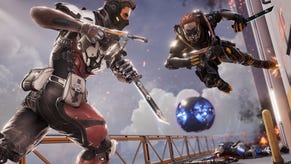LawBreakers is Unreal Tournament for the Titanfall generation
Hands-on impressions of Cliff Bleszinski and Bosskey's gravity-bashing arena shooter.
If Bosskey's daring, uneven debut has taught me anything, it's that every blast cloud has its silver lining. We're a few minutes into a round of Capture The Flag variant Overcharge on the Grandview map - a mixture of Black Ops 3's Combine and Shanghai from Deus Ex: Human Revolution, furnished with jade statues of rampaging samurai, a golden temple bell on a central rock spur and sprays of cherry blossom that make surprisingly effective aerial cover.
The idea in Overcharge is to claim a battery from the map's heart, ferry it to your base and defend the thing while it powers up - the twist being that the other side can yank victory from the ashes by stealing your prize when it's a few percentage points from full. It's a capacity for reversals derived, like much else in LawBreakers, from sport. "That's one of the things I've tasked my design team with," declares Bosskey's co-founder Cliff Bleszinski, who seems to have lost none of his old energy for spending two years outside the industry following his departure from Epic in 2012. "Give me modes that end with drama, because I've learned to love sports in my adult life, be it soccer, American football, NCAA basketball, and those last second buzzer beaters are what makes the crowd go wild."
I'm following our battery carrier out of the other team's base when everything goes a bit Dawn of Justice: a hovering Vanguard player unleashes her Starfall slam attack, splatting the poor man like a meringue. Seeking the vengeance only a barrage of unguided munitions can provide, I switch to my Titan's rocket launcher, sally forth and am suddenly, miraculously airborne. A side effect of Starfall, you see, is that it creates a brief, shimmering pocket of low gravity around the point of impact.
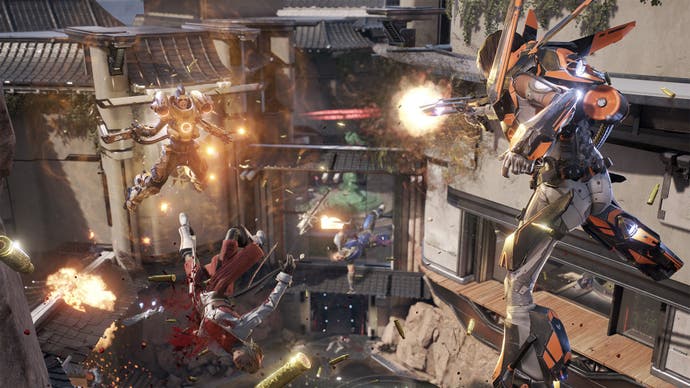
In theory this is an opportunity for the Vanguard to clean up, rinsing out-of-cover players with her Gatling gunarm before they can adjust, but all too often it gives the target an edge. Particularly if you're playing a Titan, the toughest and least agile of the game's four classes - after all, it's much easier to do damage with a launcher when you have the advantage of height. In short order I pound the attacker to a drifting paste, the recoil kicking my dreadlocked bruiser higher and higher as reinforcements pile into the area and are annihilated in turn. It's all so very exhilarating that I completely forget about the battery, which is quietly returned to its socket. Sorry, team! Take the highs with the lows, am I right?
If you're looking for the elevator pitch on LawBreakers, it's as follows: this is the ethos behind Quake's rocketjump applied to an entire arsenal. It's not just a shooter that trades on verticality, but one in which almost every weapon - from the Enforcer's no-nonsense carbine to the Assassin's fizzing shotgun - doubles as a means of traversal. It's also a game that flips the concept of blindfire upside down, in a cheeky thumbing of the nose to Bleszinski's reputation-making Gears of War games. In Gears, blindfire is what you do when you're pinned, hurting and struggling to open up a window of escape. In LawBreakers, blindfiring is all aggression. It pops your gun over your shoulder and blasts away to create momentum in a low gravity environment.
All the maps will feature low-G sections, in addition to the fleeting dollops of freefall players may conjure up using certain class skills. On Grandview, there's a nice fat bubble of the stuff around the battery spawn point, squarely between each side's base. Needless to say, this rather complicates the initial rush to the objective. Sometimes you'll line up your approach just right, leaping into the bubble and zipping through the battery's capture radius on a trail of bullets, like an insouciant comet. More often, you'll whack your shins on its pedestal and tumble, magazine half-empty, into the jaws of a counterattack.
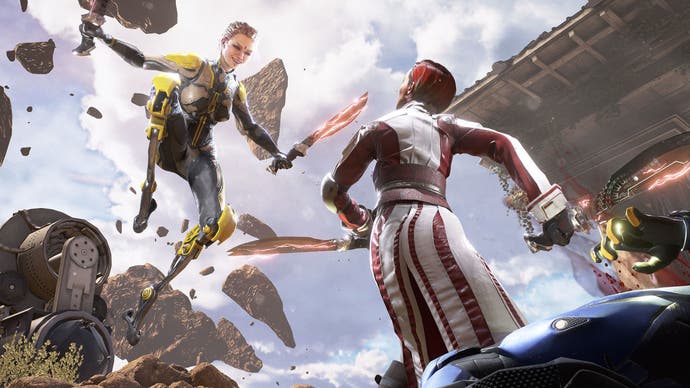
The game's classes are just as unorthodox, though there are dashes of the familiar in the shape of class-specific grenade types, primary/secondary loadouts, and a super ability that takes a minute or two to charge. The Titan, as noted, is all bite and no bounce. It has firepower aplenty in the shape of the launcher, an electricity rifle and a ground-pound, and can deploy mines that strengthen gravity nearby, but is easily out-manouevred. Its special ability is a berserk state which causes lightning to spew from its sausage fingers and emits a small shockwave on activation.
The latter trick makes for a great riposte to the brittle yet devastating Assassin, who handles like the lovechild of Dishonored's Corvo and the Bionic Commando. Her dual blades kill most opponents in three hits, and her grapple line is the game's most effective, though hardest to master traversal tool. An adept might use it to sashay perilously around map exteriors, double-jumping at corners to allow for the grapple's cooldown, and throwing in a few ninja dashes to surprise defenders. A neophyte might prefer to just grapple unaware enemies and reel themselves in for the kill, assuming you don't accidentally lasso a pillar instead and treat yourself to a faceful of wall.
The Vanguard is also built to cover ground quickly - her afterburners let her zip through the air like a jetplane, which sounds brilliant till you leave everybody behind and plunge into the enemy's midst, like Han Solo running down a Stormtrooper platoon single-handed. Fortunately, the Vanguard also packs a sort of Force slap move that propels both her and the target up and away, buying you a second to spin up that Gatling arm, which grows more accurate and damaging the longer it's fired. The Enforcer, finally, is the obligatory Modern Warfare dude, and the most accessible of the game's classes, equipped with a carbine, a handcannon, a grenade that disables ability use and a time dilation ability that boosts your speed. His special is a shoulder-mounted homing missile launcher, which emits a telltale red targeting beam.
There is, or so the watching designers maintain in the face of my flailing incompetence, a fearsome amount of depth to each class and how they compliment or counteract one another. Where many multiplayer developers shy from talk of exploits before release, wary of creating the impression that the balance is askew, Bosskey is happy to expound on the feats of trickery and dexterity it has witnessed in the testing labs. There's a certain art to saving yourself when you're kicked off the map, for example - Titans are, in theory, screwed, but who knows, a timely ground-pound might save your bacon. There's also the odd prospect of hurrying slower team-mates along during objective capture matches by, say, sprinting into them with time dilation active, or even using the Assassin's lasso to slingshot from an ally's shoulders.

It's an arrestingly weird set of duelling options, at once a throwback to Bleszinski's Unreal Tounrnament days and a response to the likes of Titanfall - and the price we pay for that oddness, naturally, is a steep learning curve. LawBreakers is a fascinating game to analyse, but it's not always fun to play. The classes have very precise strengths and weaknesses - the Assassin is an absolute wrecking ball given a blind corner and room to strafe, but easy-enough prey when caught in a corridor - and the absence of a radar or minimap may throw off anybody arriving fresh from Call of Duty (this is somewhat offset by a subtle lighting effect that makes character models pop out at range). The mild terror all this inspires is compounded, of course, by the lack of a single player mode or the option to play against 'bots, which would have been a nightmare to program and balance given the emphasis on acrobatics.
I pressed lead designer Dan Nanni about the entry threshold after my hands-on, and he made reference, a little worryingly, to the MOBA. "League of Legends does a good job of this. The first time you play League of Legends, you get destroyed extremely fast, everybody's calling you a noob, and that's a bad situation to be in. But what you do get at the very least is, you see the promise of a really cool game. You see the promise of if I like these styles of game, there's a lot more left to play for, because obviously I'm not doing something right, but it isn't because I haven't equipped myself with the most powerful gear." It's admirable that Bosskey expects commitment from players, and refreshing that the emphasis is on honing skills rather than unlocking them, but there's such a thing as being too arcane for your own good, and that's before you consider the competition.
LawBreakers is very much a world unto itself, but its creators are mindful that comparisons could be damaging. Earlier this year, Bosskey announced that it had added some grit to the art direction, in order to stand apart from what Bleszinski terms the "super candy-coloured" aesthetic of rival hero shooters like Overwatch or Battleborn. This follows the decision to dump free-to-play, as Bleszinski felt that monetisation systems might sully the experience. Instead, publisher Nexon will sell the entire game and every scrap of post-release DLC for an estimated $20-30, with cosmetic items available separately in the vein of Counter-Strike: Global Offensive. It seems a decent proposition, but that's without knowing anything concrete about the other maps, character classes and modes.
The great and maddening thing about the games industry today is that you never know what might rise to the top. LawBreakers may struggle to lure players away from more accommodating shooters, but whether it captures your imagination or drives you off, I suspect it'll make a lasting impression. So far, this is a bracingly atypical and testing contribution which demonstrates that designers needn't be cramped by the market's relentless thirst for gunplay, providing they have the wit to reimagine the guns in question. I hope Bosskey finds its feet amid the throng or rather, high above it.
This hands-on is based on a press trip to Bosskey's headquarters. Nexon paid for travel and accommodation.
